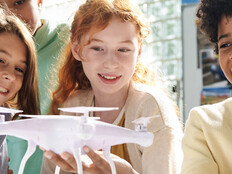Are Libraries the Key to Teaching Computer Science?
As many education tools go digital, some people have feared that libraries may go the way of the dinosaur. However, the skills that students need to thrive in a modern world continue to adapt, and they need places where they can learn such skills. Libraries have the opportunity to become havens of future-ready skills lessons to meet that need.
Libraries Ready to Code, a program from the American Library Association and Google, aims to do just that by making sure “libraries have the resources, capacity, and inspiration to embrace activities that promote computational thinking and computer science among our nation’s youth.”
With the initiative now in its third phase, School Library Journal reports that ALA and Google will select up to 50 libraries to receive resources and support to develop coding programs, and participating libraries will assist with creating a toolkit for all libraries to use. The competitive application process — open to both school and public libraries — will run until the end of August.
“You don’t need to write code,” said Google engineer Jessie Chavez at the announcement of the program. “We don’t need everyone to be an expert programmer to teach and motivate kids to seek programming as a career.”
Chavez explains in the SLJ article that libraries can reach out to all types of students in all age groups and backgrounds and really “change perceptions of who can code.”
SIGN UP: Get more news from the EdTech newsletter in your inbox every two weeks!
Libraries Can Open Doors to Innovative Learning
This concept of making libraries into places where students can learn new skills is supported by the NMC Horizon Report 2017 Library Edition. The report, which tracks and projects the trends for libraries, indicates that rethinking the purpose of library spaces is key to offering the best experience for students.
But, this concept isn’t entirely new. Over the past few years, libraries have been embracing innovation by transforming into makerspaces. The first library makerspace was created in 2013 at upstate New York’s Fayetteville Free Library, when a graduate student proposed the idea of bringing in a 3D printer, The Atlantic reports. Now, that library has a 2,500-square-foot Fab Lab that encourages science, technology, engineering and math (STEM) skills.
In another article, The Atlantic frames makerspaces as an expansion of the vast internet and computer access that libraries were already providing their patrons.
Research from the National Science Foundation indicates that with demands of all kinds on educators, public libraries are the perfect place for students to explore STEM and develop interest in STEM careers.
“Public libraries are a long-standing and promising environment for informal education opportunities,” reads the report.
The NSF’s research also found that many STEM professionals indicated that informal education — like Libraries Ready to Code or makerspaces — was the basis of their interest in STEM. This is particularly true for minority groups and girls, who are currently less inclined to pursue STEM careers.
“Public libraries provide a ‘third space’ beyond the formal classroom and home that can unite schools and communities around STEM education and complete the community’s STEM learning ecosystem,” reads the report.









